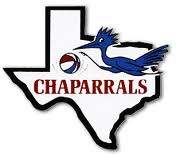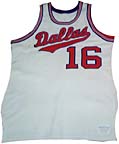This is the second in a five-part series on The History of the San Antonio Spurs (© Whitman Publishing, LLC), which was recently released and is written by Sheridanhoops.com columnist Jan Hubbard (twitter: @whyhub). In this excerpt, the roots of the Spurs franchise are traced back to the first six colorful, but largely futile years the franchise spent as the Dallas Chaparrals. (You can order the book here.)
 The Chaps managed to last six seasons in North Texas but never generated excitement. All too often, their crowds were closer to three figures than five, and by the time the 1972-73 season ended, the owners had tired of losing money. They knew of successful businessmen Angelo Drossos and B.J. “Red” McCombs in San Antonio and approached them with a unique offer to lease the team for three years. Drossos and McCombs would have an option to purchase the team at the end of the lease, but the most enticing part of the offer was the amount of the lease.
The Chaps managed to last six seasons in North Texas but never generated excitement. All too often, their crowds were closer to three figures than five, and by the time the 1972-73 season ended, the owners had tired of losing money. They knew of successful businessmen Angelo Drossos and B.J. “Red” McCombs in San Antonio and approached them with a unique offer to lease the team for three years. Drossos and McCombs would have an option to purchase the team at the end of the lease, but the most enticing part of the offer was the amount of the lease.
One dollar.
Why so cheap? In the words of one of the Dallas owners at the time, “We didn’t want that sucker back.”
The Spurs certainly had a challenge. No one had ever thought about bringing a major league team to South Texas, and four decades later, there still is only one in the four major sports leagues.
It is not simply a successful, small market franchise, however. It is a team of enormous stature. If tradition is a byproduct of winning, the Spurs are the fourth greatest franchise in NBA history. The Boston Celtics have 17 titles. The Lakers of Los Angeles and Minneapolis have 16. The Chicago Bulls have six.
The San Antonio Spurs have four.
 The current franchise, however, bears no resemblance to the one that left Dallas in 1973. In four of their six seasons, the Chaparrals had a record of .500 or better. But when they were bad, they were very bad. Their overall record was 222-260 and that included 28-56 in the final season, which proved to be the breaking point in Dallas.
The current franchise, however, bears no resemblance to the one that left Dallas in 1973. In four of their six seasons, the Chaparrals had a record of .500 or better. But when they were bad, they were very bad. Their overall record was 222-260 and that included 28-56 in the final season, which proved to be the breaking point in Dallas.
They managed to make the playoffs five times, but won only one series. They had good players, colorful players and many who would have been better off in YMCA leagues. Unfortunately, some of their most impressive records were negative ones – they may not have led the league in fewest tickets sold, questionable promotions and lack of revenue, but they were certainly in contention.
“What I noticed more than anything,” [forward Len] Chappell said, “was that fans came dressed as empty seats. There just weren’t many people there.”
Chaparral history began optimistically in 1967. They were coached by Cliff Hagan, who had an outstanding NBA career. Hagan was a six-time All-Star who averaged 22.3 points in his 10 years with the St. Louis Hawks. He was good enough to have been traded along with “Easy” Ed MacCauley for Bill Russell in 1956. While that trade created a Celtics dynasty, the Hawks did manage to win one championship in 1958.
At age 35, Hagan had been retired for a year, but a chance to be a player-coach in the ABA and pick up another paycheck was enticing. The ABA managed to attract a few of the top collegians – Mel Daniels, Jimmy Jones, Byron Beck and Bob Netolicky were taken in the top 18 picks in the NBA draft but signed with ABA teams.
But it was primarily a league of older players like Hagan and Chappell, who were at the end of their careers, and younger players not quite good enough to play in the NBA.
The Chaps were led in scoring by Bob Verga of Duke, who had been taken with the 25th pick in the NBA draft by St. Louis. Verga averaged 23.7 points but played in only 31 games because he had a military commitment and was called to duty. John Beasley of Texas A&M averaged 19.7.
But it was Hagan’s team. And that meant a team that would play a nasty form of basketball that was much closer to a barroom brawl than a dignified match between gentlemen. At 6-foot-4, 210 pounds, Hagan had flourished against larger men on NBA front lines with a fearless approach and an understanding how to use his elbows and fists.
“The Dallas owners were mostly SMU graduates and they were principled, classy guys,” said Terry Stembridge, who was the Chaparrals play-by-play announcer and public relations director. “But I don’t think they were prepared for the way Cliff played. The NBA was a brutal, tough league at the time and it was far different from watching SMU basketball. Cliff was one of the toughest guys in the NBA and he brought that with him.”
One Sunday afternoon in the first season, the Chaps had a “Kids Day” promotion that encouraged families to attend the game. The Chaps were playing well and Stembridge said the team was thrilled when a crowd of 7,500 attended.
The opponent that day was the Minnesota Muskies, and one of their tough guys was 6-7 Les Hunter, who was on the 1963 NCAA championship team at Loyola-Chicago. During the game, Hunter used his elbows repeatedly on Hagan, who became irritated and told Hunter one more elbow and they’d fight.